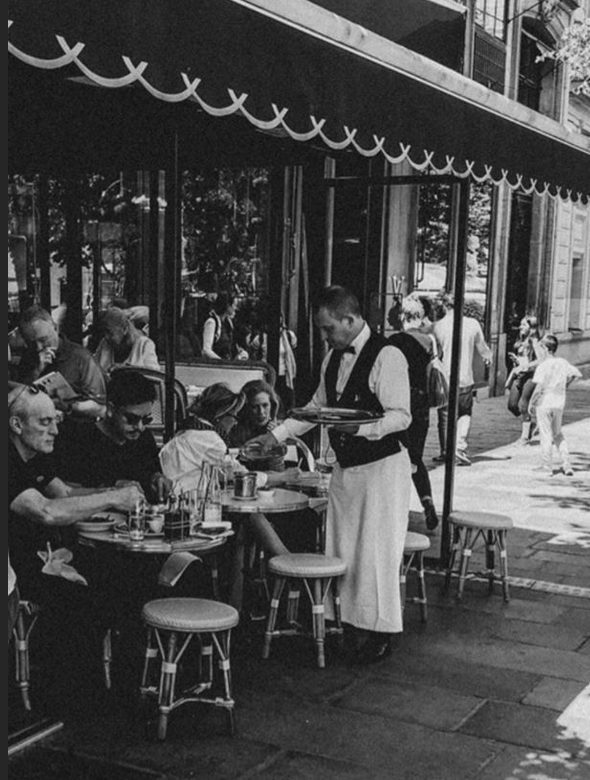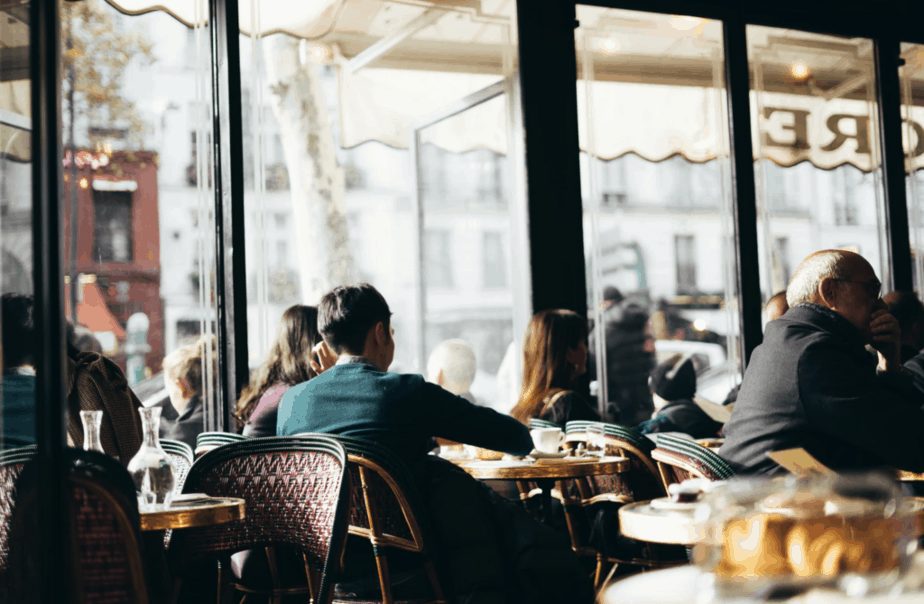A Parisian’s Guide to French Restaurant Etiquette
One of the most wonderful things about Paris is the food! Dining out is a huge part of the culture in France, and with so many great restaurants it’s easy to see why.
Though there’s no doubt you’ve heard horror stories from people who’ve had terrible experiences in French restaurants. Despite the food being excellent, “it takes forever”, “the service was awful”, and even “the waitstaff was downright rude” are some of the common complaints I’ve heard over the years. For these reasons, French and especially Parisian restaurants have a bad reputation abroad.
But I’m willing to bet this is because these visitors simply didn’t understand French restaurant etiquette. Just like with so many other cultural differences such as language and timing, dining in France can be intimidating. I know firsthand that it can be hard to adjust, so don’t worry!
I’ve put together a helpful guide here, all about understanding French restaurant etiquette. Basically, this guide, a little patience and an open mind are all you need to have the best Parisian restaurant experience! After reading this guide, you’ll know how to avoid any faux pas and ensure that you have a great meal out in Paris!
1. Timing
One of the most common faux pas people make with regards to French restaurant etiquette is bad timing. Depending on where you’re from, one of the first things you’ll notice in Paris is that people generally eat at different times than what you’re used to.
This is because the average French person eats lunch around 1 or 1:30 P.M. and sits down to dinner around 8 P.M. For many anglophone and some Nordic countries, this is quite a bit later than usual. On the other hand, meals are eaten much earlier in France than in Mediterranean countries like Italy and Spain.
Restaurants generally follow the Parisian timetable. So they open for lunch and dinner, but don’t usually stay open all afternoon. Since many Parisians like to enjoy an after work apéro or cocktail hour, before going out, you’ll find that most restaurants won’t open before 7 P.M. And this means that the amazing Parisian brasserie you’ve been dying to try might not even be open at your usual “dinnertime”.
My advice is to try eating at the usual local time, especially in the summer months. There’s almost nothing more delightful than watching the sun set over Paris from a café terrasse.
2. Patience
People always rave about how delicious French cuisine is. Unfortunately, this is usually followed by “but we had to wait forever, and the service was so slow!”
Yes, it probably was. And that’s just how it is here, it doesn’t mean that your server was inattentive, slow or rude. It’s just that food is an important part of French culture, and dining out is meant to be an enjoyable experience. In France, meals are not to be rushed, but thoroughly appreciated.
The French simply prefer to take their time while eating, and because of that, meals just take longer here. The same goes for the service too. That’s also because waiters aren’t trying to hurry you to ensure high turnover or a good tip. So this is the part where the patience I mentioned earlier comes in!
Once you’ve ordered, you’ll most likely be waiting awhile for the first course. Same goes for the second course, dessert, and even drinks. And when you’ve finished your meal, don’t expect the server to come right away with the check. You will have to ask for it! It’s considered extremely rude in French restaurants for a server to deliver the check before the customer asks for it. This same unspoken rule applies to ordering a single coffee and staying all afternoon. You are welcome to do so! Yep, no one will get upset or try to hurry you out the door.
In a French restaurant, you can expect to spend an hour and a half sitting down to lunch, and easily two to three hours at dinnertime. While this can seem like an eternity if you’re used to rushing through a meal, try to think of it as a great opportunity relax and enjoy like a local, and maybe even become a little bit more Parisian.
So here’s one of the most important things to take away from my guide to French restaurant etiquette: a good meal takes time.
3. Courses
Now that you know you should take your time while dining out in France, here’s why. French meals are traditionally composed of multiple courses, this typically means a starter (entrée), a main dish (le plat) and a dessert (le déssert). Most French restaurants offer an à la carte option or what’s called a menu/formule, or set menu. But the set menu option is the most poplar, and definitely a more affordable choice.
Usually the nicer the restaurant, the more courses you can expect. At most restaurants in Paris, a 3-course set menu is considered standard. Though at Michelin-starred restaurants there can be more than a dozen courses!
(Here’s how to eat at a Michelin-starred restaurant without breaking the bank).
Of course, it takes more time to prepare (and savor!) three or more separate courses than it does just one. So sit back, relax and enjoy the amazing culinary journey ahead.
4. Tax and Tipping
Another important aspect of French restaurant etiquette is knowing how to pay the bill. When the check arrives at your table (remember, you’ll have to ask for it), the total is the final price. Tax and service fees are automatically calculated into the price of each item on the menu, even drinks! This is really helpful because there are no unwelcome surprises. You know when you order a €20 formule, your bill will be €20 even.. and not one centime more.
So, you’re probably wondering how tipping works. This is by far the biggest difference between French restaurant etiquette, and protocol in other cultures (ahem, U.SA.).
In France, there’s not really a big tipping culture. For things like a coffee, or a drink in a bar, even a casual meal out; leaving no tip is both acceptable and commonplace. In nicer restaurants, rounding up is the general rule of thumb, but you’re by no means expected to leave an American-style 20%. Basically, if your bill comes to €28 you could leave €30 and so on.
This changes slightly for fine dining restaurants. The service at these places is truly exceptional! If you’re going to a luxurious or Michelin-starred restaurant for example, you should plan on leaving around 5-10% as a tip.
5. Service
Ah the service! This is the one factor that makes all the difference between an incredible or an awful dining experience. Though you should know, the service in French restaurants may not be what you’re used to!
Forget the overly-friendly server who incessantly stops by and interrupts to ask if you might like more water, if the food is alright, or simply to check on you. While this may be the norm in countries like the United States, this attitude simply doesn’t fly in France.
The servers working in typical French restaurants are actually professionals. Rather than students looking for a temporary income boost, the majority of Parisian waitstaff have attended special training and school for their profession. Which, they take very seriously. Remember, they’re not working for your tip, and they won’t be overly attentive or bothersome. But they are knowledgeable professionals, who should be treated with respect!
So if you have a special request, want to order, or would like the check, feel free to try and make eye contact with your server. If this doesn’t work, you can politely wave at them to come to your table, or signal for the check. On the other hand, you should never whistle, or yell “garçon” to grab their attention as many Hollywood movies would lead you to believe. This is actually considered very rude, and goes against good French restaurant etiquette.
A few last helpful tips..
Alright, I just wanted to leave you with a few last helpful tips. Firstly, pretty much all of the restaurants in Paris offer water for free, but you’ll have to ask for it. A carafe of tap water is a carafe d’eau and is available almost any restaurant you go to. On the other hand, if you don’t specify that you’d like a carafe d’eau s’il vous plaît you’ll be given bottled mineral water and charged (usually €5-6) for it.
Finally, when dining out in Paris, you should dress to impress. No, I don’t mean a suit and tie or anything very formal, it’s just that Parisians are known for being the world’s best dressed. So making small efforts to appear more polished are definitely appreciated, especially in restaurants. Mainly, make sure you aren’t wearing athletic gear or sports shoes. Remember you’re going out to eat, not climb a mountain.
Want more specifics? Find out what to pack for a trip to Paris here.
So now you know all the basics of good French restaurant etiquette! This should really help your dining experience in France be a positive one. If you’re a foodie, you’ll also love our guided tour, all about French food in Montmartre (yes sampling is included!).
And if you’d like some suggestions for great restaurants, or more information about French restaurant etiquette, don’t hesitate to check out some of our other articles!
See you soon in Paris!
Planning a trip to Paris ? Get ready !
These are Amazon’s best-selling travel products that you may need for coming to Paris.
Bookstore
- The best travel book : Rick Steves – Paris 2023 – Learn more here
- Fodor’s Paris 2024 – Learn more here
Travel Gear
- Venture Pal Lightweight Backpack – Learn more here
- Samsonite Winfield 2 28″ Luggage – Learn more here
- Swig Savvy’s Stainless Steel Insulated Water Bottle – Learn more here
Check Amazon’s best-seller list for the most popular travel accessories. We sometimes read this list just to find out what new travel products people are buying.















